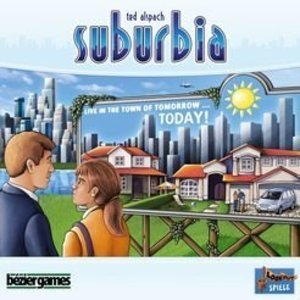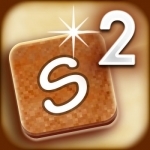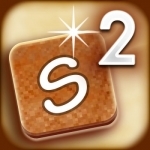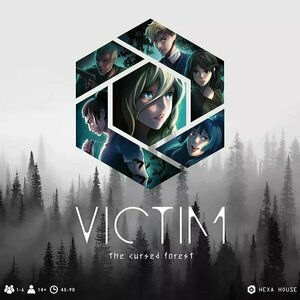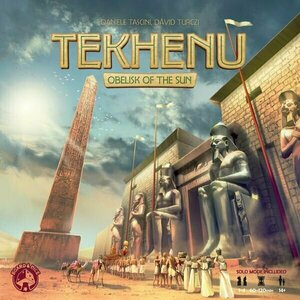
Tekhenu: Obelish of the Sun
Tabletop Game
Four millennia ago on the eastern bank of the Nile river was laid the foundation of the Temple of...
A Bibliophagist (113 KP) rated Suburbia in Tabletop Games
Feb 5, 2020 (Updated Feb 5, 2020)
At first I was overwhelmed by just how many components there are, and how complex the rules were, but once I got playing and saw how it was just Castles of the Madking Ludwig and even had similarities to the house favorite Terraforming Mars, it became extremely simple. This is definitely a play to learn game, as we played it got easier and easier. My partner and I adopted different strategies and it's the first time I've seen him be such a poor loser (I did destroy him).
Unlike Castles, the players are building a town buying properties from the board (each property rejected gets cheaper each round) and creating combos that benifet the plauers end goals and the boards end goals. The players try and raise (or lower) their reputation and towns population while generating enough income for growth. It really tickled my management game itch, as I love those silly kairosoft games and played SimTower like it was noones business back in the day. Striving to not just reach my goals but create a realistic town. My partner and I found ourselves roleplaying a little, making jokes as he placed his trailer park by the city dump, or how he sectioned his wealthy side off from the unsavory side with a series of lakes. We really got into it and I look forward to playing it again! Also, I promise, it's not nearly as complex as it looks!

Letter Club
Games, Education and Stickers
App
Letter Club is the fastest word game on planet!! Making words has never been this exciting! ...

Skate Board Revolution . Subway Riders
Games and Entertainment
App
An illegal skateboarding competition is going to take place in the subway... Are you going to miss...
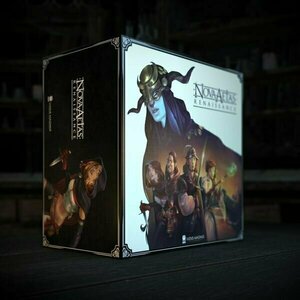
Nova Aetas Renaissance
Tabletop Game
Nova Aetas Renaissance is a cooperative tactical boardgame set in a fantastic and dark Italian...
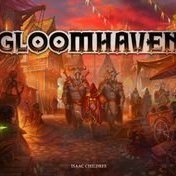
Gloomhaven
Tabletop Game Watch
Gloomhaven is a game of Euro-inspired tactical combat in a persistent world of shifting motives....
Purple Phoenix Games (2266 KP) rated Victim: The Cursed Forest in Tabletop Games
Sep 24, 2021
Victim: The Cursed Forest (which I shall from here call simply “Victim”) is a horror survival game where players assume the roles of survivors of a plane crash. Each survivor, which in the game are actually called Victims, must race against time and nightmare fiends in order to reach the safety bunker until saviors come rescue them. However, early in the game one of their own is possessed by the lurking horror and then turns on the party to pick them off one by one. It’s up to the victims to race to the bunker and input the correct code to open its hatch to relative safety!
DISCLAIMER: We were provided a copy of this game for the purposes of this review. This is a retail copy of the game, so what you see in these photos is exactly what would be received in your box. I do not intend to cover every single rule included in the rulebook, but will describe the overall game flow and major rule set so that our readers may get a sense of how the game plays. For more in depth rules, you may purchase a copy online or from your FLGS. -T
To setup, basically shuffle each deck separately, and place the Bunker map tile in the bottom six of the stack, then split that into two stacks. Place out all the chits however makes sense for your table (organized for me, thank you), and each player chooses one of the characters to play and collects all their goodies. The Start Tile is laid down, the player minis are placed upon it and the chase is on!
Each turn the players will have several choices of actions to complete, with two actions available to be taken on their turn. Primarily, players will be Running around the map to different tiles and exploring their special characteristics. Some tiles allow players to search them for Item cards, some allow players to Decode as an action, and some also require players to pass certain tests of abilities. These tests correspond to each player’s abilities of Agility, Intelligence, Vitality, and Luck. The ability scores are different for each character and can be improved or worsened throughout the game. Character boards also will show each character’s special skills that can be used on a turn.
Once all players have completed their two actions in turn order, the last player will flip an Event card that may be active for the entirety of the next round. Sometimes these Events affect only characters on certain tile types, or even adjust ability scores and Items held. However, at the end of the second or third round of play (depending on the number of players), the ominous Curse Phase is completed.
The Curse Phase is a special one-time insert that has all players make a test against one of the four abilities. The lowest score for the test then becomes the host for the Evil that will ravage the party and wreak hell on the other players. The player no longer controls their chosen character, but immediately becomes the Evil that was drawn and now plays the game against the other players. The Evil takes their turn at the end of the round, just before the Event card is drawn.
Once the Evil enters play in earnest, the game quickly shifts from a nice exploration and map building game to a race against time to earn bunker password tokens from the Decoding tiles and avoid all attacks from the now raging Evil chasing the players. I will not describe the entirety of battle and Evil special abilities, but battle is a very simple Attack roll vs. Defense roll for one wound. When a player sustains two wounds, they are considered to have a Critical Injury and may only Crawl to another player in hopes of receiving healing or to arrive on a tile with healing properties upon it. However, a character that has been Critically Injured is ripe for the Evil’s Death Skill. The Death Skill is how the Evil is able to remove characters (and thusly players) from the game and decrease the odds of the Victims’ victory.
Play continues in this fashion of players taking their turns, then the Evil takes their turn, then the Event card is drawn as the last part of each round, until either the players collect the correct tokens to solve the hatch passcode and earn safety, or the Evil takes out the required number of characters for their victory. All this can be accomplished in a mere 45-90 minutes. Absolutely.
Components. Never having heard of Hexa House prior to arranging for this review, I had no idea what to expect in terms of components. However, this game comes in a very large box, the insert is kind of perfect (which is saying a lot, especially since it is a vacuum form), and everything inside the box is really great! I’m not really a miniatures kinda guy, but I can appreciate them. Standees are just as good to me, but I think these minis are above-average from my experience. The cards, the art style, the custom dice, everything just hits really well.
So you probably noticed my weird ratings graphic up top. Well, I will admit that my graphic design skills are, well, amateur at best. So I just created a 5 point 5 because I really feel this one is just amazing. Now, some people may have some small issues with the rule book, but please read it with a grain of salt: I believe they originate in Thai or Laotian languages and are translated to English. I didn’t have problems reading it at all, but had a couple questions. I tried playing several different ways when I had these questions, and usually just one option was really viable anyway.
That said, everything else about this game is truly wonderful. I sincerely enjoy that sudden shift near the beginning of the game where one player becomes the big baddie and comes for the rest of the players. Depending on placement and buddy systems that formed in the first part of the game, the Evil player will have either a feast setup before themselves, or have to do a bit of work to track down the characters to orchestrate their attack. I know I didn’t go into a whole lot of detail on what the Evil player can do on their turns, but it boils down to basically Hunt (run), Attack, and trap.
This base game ships with six Victims and six Evils. I have yet to see all the Evils in my plays, as the mechanic for determining which Evil surfaces is dependent on a draw of a card from a shuffled deck. That said, even when an Evil enters the game that I have played before, the players were different, and the map was different, and the placement of characters was different, so it did not feel “samey” to me at all.
I will admit that the most frustrating aspect of the game is the bunker hatch passcode. Okay, so once the Bunker tile is placed, a new component enters play: the Bunker board. A hole in the middle of the board is to house a Gate Token. This Gate Token is simply a target number that the players need to achieve using the different Number and Symbol Tokens won from successful Decode actions. The Number Tokens are simply 1-6, and the Symbol Tokens are plus/minus/multiply/divide. Therefore, in order to meet the Gate Token showing 35 players would need to gather 6 x 5 + 3 + 2. That is seven different successes at the Decoder tiles, and best case scenario has players pulling those exactly and no others. When you are playing a game that is a race against time (or death, in this instance), these little setbacks can cost the entire game – that is, if players simply cannot pass the test needed for a success at the Decoder tile. Frustrating, yes, but also a very cool addition to this style of game.
Victim has completely surprised me, and I am so thankful I had the opportunity to add this to my collection. My strong recommendation is that if you see one of these in the wild – GRAB IT. There are hours and hours of gameplay in this box, and I haven’t even touched the expansion for it yet (expect another review of that in the near future as well). Purple Phoenix Games officially gives this one a 5.5 / 6 (we NEVER do half points), but I feel like with even more plays, and with the expansion to be added soon, this may give my Top 10 list a shakeup still this year. If you are a fan of games like Betrayal at House on the Hill and Posthuman, then you need to check this one out for sure. Oh, did I mention that there is a LOT of dice rolling here too? Guess I just left that until the end for my dice-chucking lovers.
